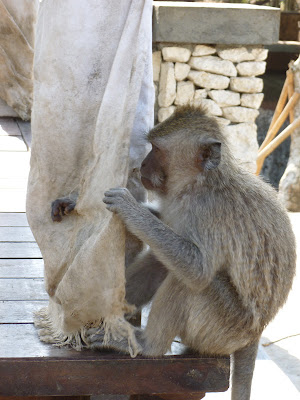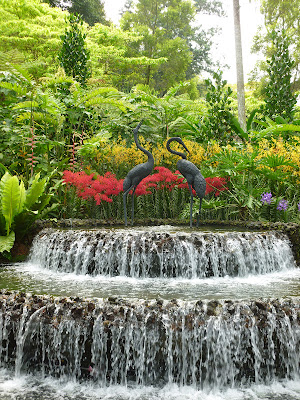Although Indonesia is predominantly Muslim, the main religion in Bali is Hinduism, though it is very much a local variation infused with animist elements. The island is said to have over a thousand temples. This is no exaggeration as there are important temples belonging to the island as a whole, at least three in every village, and most family compounds have their own. In addition, there are little shrines with floral offerings everywhere.
Some of the most important and spectacular of Bali's temples are the sea temples honouring the sea gods. Each sea temple is reputedly visible from the previous one forming a chain around the island. In addition, there are nine directional temples protecting Bali from evil spirits, which are located at auspicious sites from mountainsides to caves and cliff tops.
The 11th century temple Pura Luhur Ulu Watu on the Bukit peninsula in Bali's south is the only temple that is both a sea temple and one of the directional temples. I headed out there last weekend during the three day stopover in Bali I had on my way home and was floored by the beauty of its surroundings.
 |
| Pura Luhur Ulu Watu |
 |
| Gateway flanked by statues of Ganesh, the elephant-headed god |
 |
| The headland immediately south of Ulu Watu |
 |
| One of the wildflowers growing near the cliff face. I'm guessing some kind of milkweed, which is an important food source for the larva of some butterflies, particularly the monarch, and there were some spectacular butterflies around. |
 |
| The headland looking to the north from Ulu Watu |
 |
| In the distance are a handful of tourists photographing the resident monkeys, but I was intrigued by the forest in the background. At the end of the dry season in the tropics, many flowering trees lose their leaves and burst into flower. Back home in Brisbane it happens most noticeably with jacarandas and the poincianas. I don't know what kind of trees these are, but I suspect that in just a few weeks this backdrop could be spectacular. |
 |
| This young macaque was fascinated by the hole in the fabric. |
 |
| Temple guardians |
On my earlier visit in June, I visited what is probably the most well-known and most frequently photographed of the sea temples. Pura Tanah Lot is said to have been established in the 15th century by a travelling monk called Nirartha. It is built on a group of rocks at the end of a headland, which becomes an island as the tide comes in.
 |
| The priests give a blessing signified by a few grains of rice on the forehead in return for a small donation. |
Then, on the very next headland, yet another temple Pura Batu Bolong. My fear of heights overruled the temptation to cross the land bridge for a closer look.
Whenever I am lucky enough to return to Bali, I would love to visit more of the sea temples. There are seven important ones, so that's at least five to add to my bucket list. And then there are the directional temples...






























































